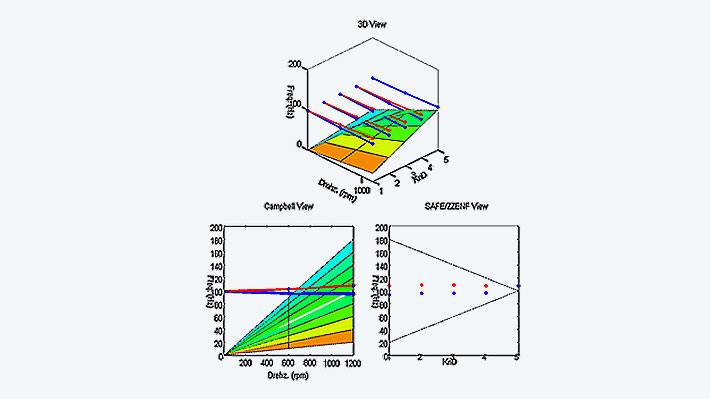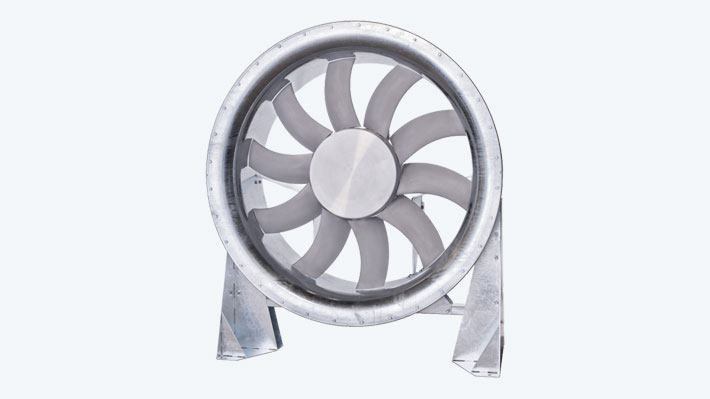Rotor dynamics and strength calculation (FKM) with CADFEM ihf Toolbox
Sector: Machinery and plant engineeringSpecialist field: Structural mechanicsLuwa Air Engineering AG is the leading supplier of industrial ventilation systems. The importance of energy efficiency in the Luwa product range is reflected in the newly developed axial fan B600, which sets best marks in aerodynamic efficiency. CADFEM supported the development with simulations from the CADFEM ihf Toolbox, which contains all the calculation tools required for this task.
Summary
Task
The goal for the new generation of Luwa axial fans was lower power consumption, higher fan performance and lower noise levels. CADFEM was tasked with analyzing the structural integrity of the fan blades. During operation, the blades must not resonate while being subjected to centrifugal and aerodynamic loads.
Solution
In order to avoid resonances, the rotor-dynamic behavior was analyzed by modal analysis incorporating gyroscopic effects. The calculated eigenmodes were then assessed using the Campell and SAFE diagrams to rule out interactions between rotational speed, disk node diameter and blade natural frequencies.
Customer benefits
Luwa Air Engineering AG was able to improve the design by approximately 4%, resulting in 1.2 MW less energy consumption per year for all installed fans. In addition, the prototype and personnel costs, for the five design iterations that would otherwise be required, have been eliminated, representing a savings of more than €80,000.
Project Details
Task
Luwa Air Engineering AG is the leading supplier of industrial ventilation systems. The importance of energy efficiency in the Luwa product range is reflected in the newly developed axial fan B600, which sets best marks in aerodynamic efficiency. Axial fans for supply and exhaust air are the main consumers of electrical energy in spinning and weaving mills. In a spinning mill, this accounts for about 55% and in a weaving mill, up to 75% of the total electricity consumption of the air conditioning and filtration systems. The goal for the new generation of Luwa axial fans was lower power consumption, higher fan performance and lower noise levels. CADFEM was tasked with analyzing the structural integrity of the fan blades. During operation, the blades must not resonate while being subjected to centrifugal and aerodynamic loads.

Customer Benefit
Luwa Air Engineering AG was able to improve the design by approximately 4%, resulting in 1.2 MW less energy consumption per year for all fans installed. Rotor-dynamic stability and structural integrity were achieved without lengthy physical prototyping and testing cycles. In addition, the prototype and personnel costs, for the five design iterations that would otherwise be required, have been eliminated, representing a savings of more than €80,000. Through simulation, resonance problems have been eliminated from the outset. Furthermore, a deeper insight into the behavior of the overall system could be gained than would have been possible through testing.

Solution
In order to avoid resonances, the rotor-dynamic behavior was analyzed by modal analysis incorporating gyroscopic effects. The calculated eigenmodes were then assessed using the Campell and SAFE diagrams to rule out interactions between rotational speed, disk node diameter and blade natural frequencies. To achieve this goal, several geometry evolutions of the blade were analyzed. When the dynamic behavior was sufficient, the strength verification could be performed. In the first loading step, a bolt preload was applied to simulate the assembly of the fan impeller. In the second loading step, the rotational speed and the aerodynamic pressure values - calculated with ANSYS CFX - were introduced. The calculated stresses were evaluated using WB/FKM from CADFEM ihf Toolbox. WB/FKM is an implementation of the FKM guideline “Analytical Strength Assessment” within ANSYS Mechanical Workbench and provides an automated evaluation of the static and fatigue loading over the entire surface.
Images: © Luwa Air Engineering AG




